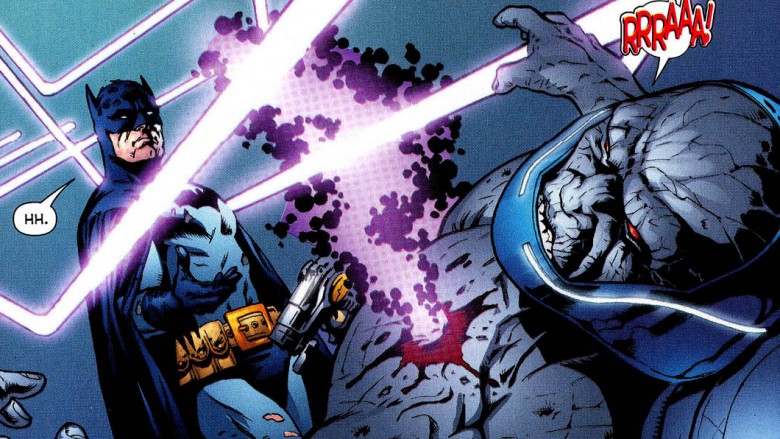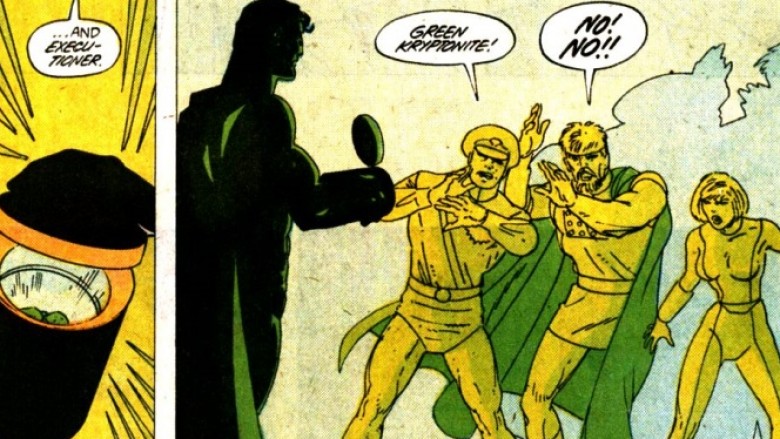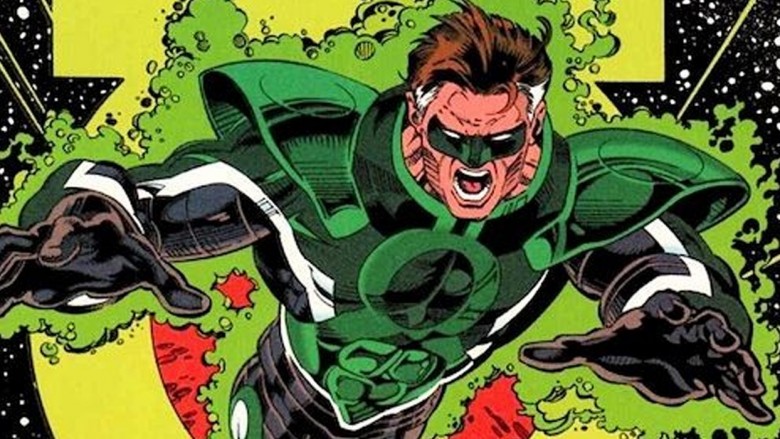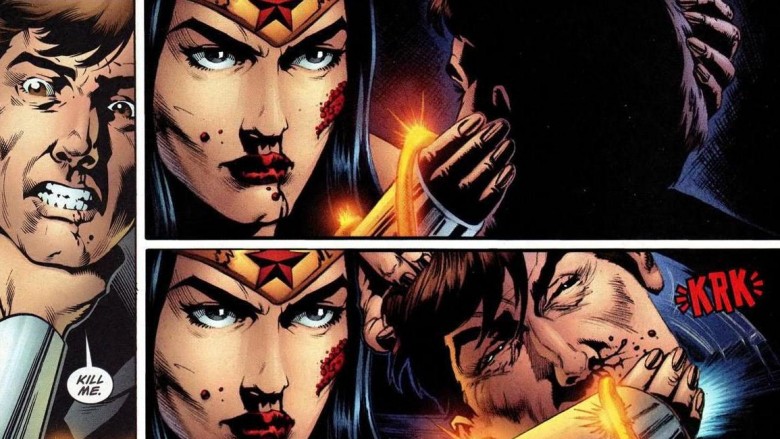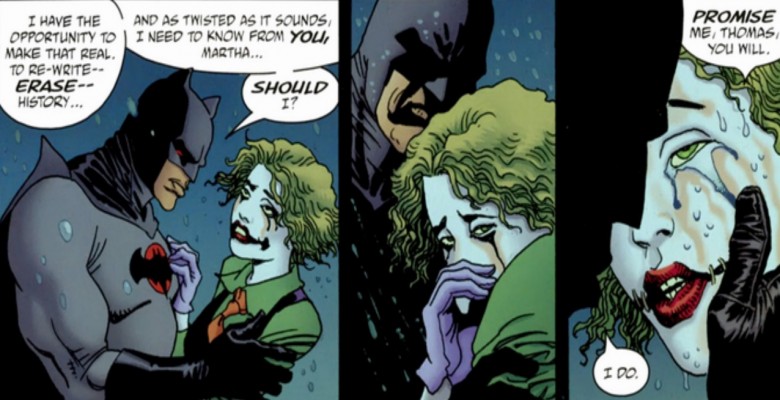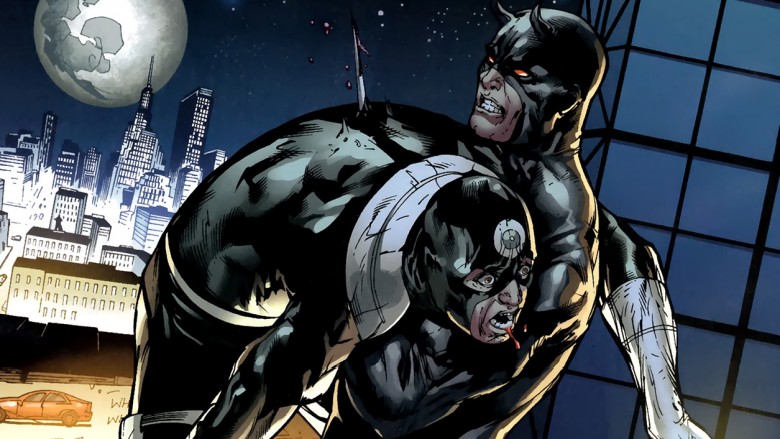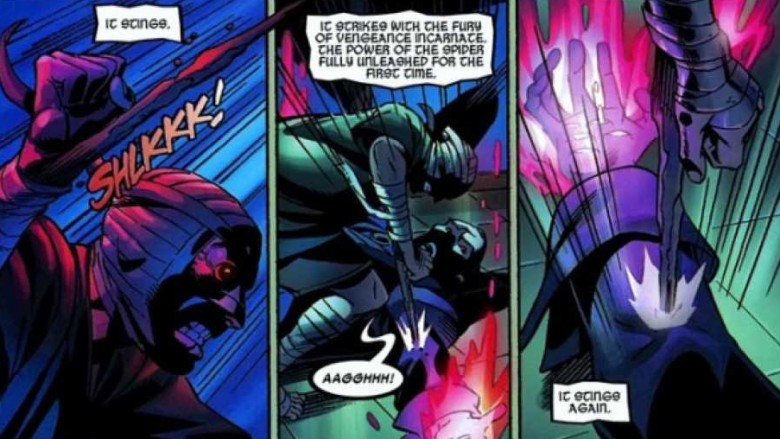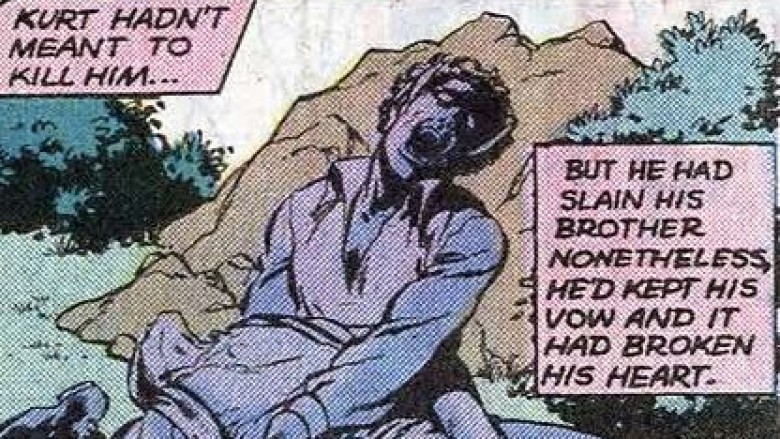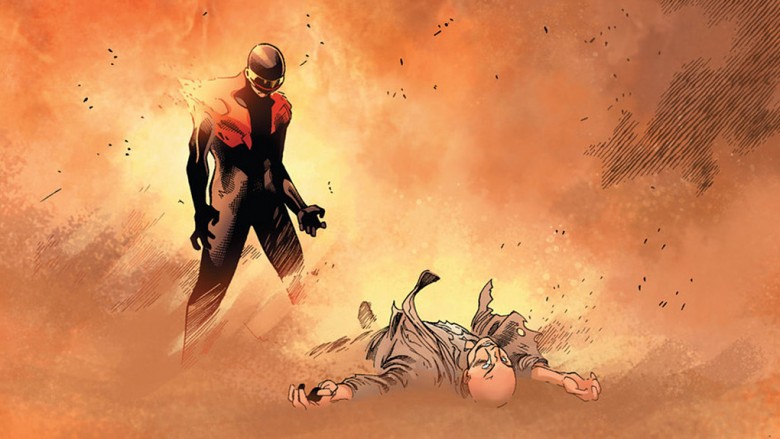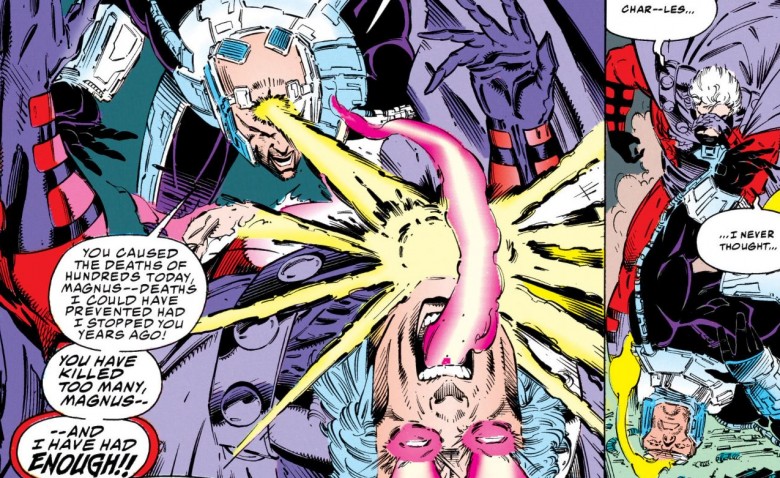Times Superheroes Broke Their Own Rules
Every superhero has a code—it's what sets them apart from the villains they face. But no matter how noble they might be, living up to those ideals isn't always easy, and if a character fights crime long enough, they're bound to cross some crucial lines eventually. Sometime it happen because of outside interference or control; other times, it's a sacrifice made in service of the greater good. It's happened countless times in the comics over the years, but you don't have to dig through decades of back issues to track these incidents down...you just need our mint-condition, lenticular foil cover guide to the times superheroes broke their own rules.
Batman tries to kill Darkseid
Batman is a complicated guy—from the way he fits decades of James Bond-worthy gadgets into a single belt to his frequently tortured psychology. But his moral code, on the other hand, is pretty simple: he doesn't kill people, and he doesn't use guns. This obviously isn't always true onscreen, but the comics have been pretty consistent on this front.
With one notable exception: the time Batman tried to kill Darkseid with a gun. In Final Crisis #6, Darkseid is literally a threat to the entire Earth, and Batman decides it's worth going against his moral code to save the planet, shooting Darkseid with a special bullet capable of killing gods. He only ends up hitting him in the shoulder, however, and before he even has time to lament that he would have had better aim if he didn't avoid guns most of the time, Batman is apparently killed by Darkseid's scary eye lasers.
Of course, we later found out Batman was actually sent on a bizarre time-traveling adventure which was meant to undo all of reality. If that wasn't weird enough, DC eventually offered a clumsy retcon of this issue and claimed that this murderous Batman was actually a crazy clone created by Darkseid.
Superman kills alternate universe Zod
There was a considerable amount of fan outcry in Man of Steel when Superman decided to kill Zod. After all, Superman is known as the hero who always finds a better way. Interestingly, though, this is one area in which director Zack Snyder was not only true to the comics, but arguably did a better job of portraying the death of Zod.
In John Byrne's Superman #22, the Supergirl of another dimension brings in our Superman to help deal with their dimension's Zod and his two Kryptonian compatriots, who'd been on a horrific murer spree, ultimately wiping out all life on Earth. Their powers had already been sapped by golden Kryptonite, so they weren't actually a threat anymore, but Superman wasted no time executing all of them with their dimension's green Kryptonite (which conveniently didn't affect Superman himself). It was a really, really dark moment for a typically squeaky-clean hero, and it came back to haunt him years later in JLA #35, in which the Spectre, whose job is to punish men for the evil in their souls, points out that even Superman isn't above committing cold-blooded murder.
Hal Jordan's killing spree
While there have been a lot of Green Lanterns, Hal Jordan remains the most famous. He's a character cut from the classic DC hero mold: square-jawed, iron-willed, and generally opposed to killing anyone. After all, his ring is the most powerful weapon in the galaxy, which puts him in a better position than anyone to find a non-lethal way to deal with supervillains. Yet on one memorable occasion, Jordan went on an absolute killing spree...and ended up offing far more heroes than villains.
During the 1992-'93 Death of Superman story arc, an alien named Mongul and the Cyborg Superman completely destroyed Hal Jordan's hometown, Coast City. Hal had already been under a lot of stress, and this loss was just too much to bear. He became obsessed with using his ring to bring the town and its people back, and tried to use the Central Power Battery to go through with his crazy plan. He defeated fellow Lanterns, killed his friend Kilowog, killed his enemy Sinestro, and eventually murdered the Guardians by absorbing the battery. This de-powered the rings across the galaxy, so anyone who was flying through space or fighting a villain at the time died, too. All of this was so catastrophic to the character that the company later retconned the whole thing and pinned it on an alien parasite controlling Hal.
Wonder Woman snaps a neck
Wonder Woman, like most of the Justice League, typically avoids taking lives. She's rarely in a position where she has to: she has strength and endurance much like Superman, along with a bevy of magical accessories that includes a lasso that can force people into telling the truth. She never really has to kill out of self-defense—but one time, she committed murder to save the world.
Maxwell Lord once worked with the Justice League, but was secretly plotting to control the group for his own evil ends. He was secretly worried about how metahumans could be a threat to humanity, a fear that was crystallized when Mongul destroyed Coast City, killing Lord's mother. In Wonder Woman #219, Lord used telepathic powers he gained from an alien invasion to control Superman's mind, making Superman attack and kill on command. Wonder Woman put her Lasso of Truth around Lord and asked what it would take to free Superman, to which Lord offered an honest response: "Kill me." Taking him at his word, she snapped his neck. Wonder Woman's actions caused a temporary rift with Superman and Batman, but they eventually found common ground again.
Flash rewrites all of reality (twice)
As the Flash television show has made abundantly clear, this superhero is no stranger to time travel. This means he's intimately familiar with the butterfly effect: any small changes he makes when he travels to the past can have grave repercussions on the future. He ignored that danger when he went back in time to keep evil speedster Eobard Thawne from killing the Flash's mother...and in the process, he wrecked reality.
As it turns out, saving his mother's life (and the subsequent use of the magical Speed Force to do it) ended up altering the universe in some wild ways. Bruce Wayne was now dead, his father was now Batman, and his mother was now the Joker. Superman was a lab rat, and Aquaman and Wonder Woman were literally taking over the world. When Flash realized he was responsible for all those changes, he attempted to do the right thing by going back in time again and letting his mother die—a noble sacrifice that mostly returned reality to its familiar shape, but messed up characters' histories and relationships, setting off DC's controversial New 52 era in the process.
Daredevil kills Bullseye
He's more morally gray than most, but Daredevil typically refuses to kill. This is understandable because Daredevil, who is lawyer Matt Murdock by day, knows the dangers of being a one-man justice system—but he still once made an exception for his nemesis Bullseye.
As comics readers know, Bullseye has tormented Daredevil for years. He killed Daredevil's former lover Elektra, and even though she later came back to life, the sting never really went away. Later, he killed Matt's girlfriend Karen Page, and that death was actually permanent. Over the years, Daredevil became more brutal towards Bullseye; at one point, our blind protagonist actually carved a bullseye into his enemy's head. Bullseye eventually committed mass murder, leaving Daredevil feeling responsible for not just killing the guy years ago—so he impaled his old foe in an ironic homage to Elektra's death.
After all that, Bullseye was later revealed to have barely survived (it's the comics!), which was a particularly weird retcon considering Daredevil tried to exhume Bullseye's corpse after the murder.
Spider-Man kills Morlun
Spider-Man is one hero who's always fallen firmly in the "never kill" category. Like Batman, his story is rooted in the needless murder of a relative, so he has more reason than most to value life. He did break this code, once but his longtime love Mary Jane was in mortal danger...and Spider-Man, in the finest tradition of weird comics, wasn't exactly himself.
This all went down in a storyline called "The Other," published during a weird time in which Marvel explored the idea that Spider-Man was actually powered by mystical energies instead of a radioactive spider bite. Facing a vampiric being named Morlun while fighting a fatal illness, he was beaten senseless by Morlun, who later showed up at the hospital to try and feed on him. Stopped by Mary Jane, Morlun was prepared to kill her—but then the mystical totem inside Spider-Man's body took over, transforming him into a sort of man-beast with spider stingers. Of course, this was a true "kill or be killed" scenario, and Spider-Man died immediately afterward—although he didn't stay dead, and neither did Morlun. None of which changes the fact that Spider-Man brutally and intentionally killed a foe.
Nightcrawler kills his brother
As a group, the X-Men are surprisingly mixed about killing people. Some characters, such as Wolverine, do it with abandon, while others, such as Rogue and Colossus, become reluctant killers. Nightcrawler has always been a moral center of the group—he's gentle, lighthearted, and extremely Catholic: basically, the last guy you'd expect to kill anyone. Surprisingly, though, Nightcrawler's X-Men adventure started with him killing his own brother.
In the X-Men Annual #4, it's revealed that Xavier discovered Nightcrawler on a busy night. As X-Men fans know, the blue mutant was being chased by villagers intent on killing him because they blamed him for the murder of some local children—murders actually committed by Nightcrawler's brother Stefan. Nightcrawler knew he had to stop his brother, and ended up killing Stefan in the fight. Due to Nightcrawler's demonic appearance, the villagers thought he was behind these gruesome killings, and they would have killed him if Professor X hadn't come to his rescue. Nonetheless, this incident marks one time when the action of the purest and most devout X-Man ended in death.
Cyclops Kills Xavier
Cyclops spent years as one of the more straight-laced X-Men. One of his most defining characteristics was a desire to plays by the rules—including avoiding killing whenever possible. He was capable of crossing that line, however—as he did when he actually killed his beloved mentor, Charles Xavier. This incident ended up profoundly changing his life and the entirety of the Marvel Universe.
It all went down in Avengers vs. X-men #11, after the Avengers tried to disrupt the Phoenix Force and instead succeeded in splitting it into multiple parts that inhabited five X-Men, giving them godlike powers. Cyclops, possessed by the Phoenix Force, set about reshaping the world; Xavier tried to coax him back from madness...and was murdered by his powerful protégé.
As comic book deaths go, this had some lasting weight: Xavier stayed dead a good, long while, even as Cyclops became a wanted murderer who led the next generation of mutants down a dark and often violent path. And while some argue it wasn't his fault since he was bonded with the Phoenix Force, the death of peaceful dreamer Charles Xavier is completely in line with the increasingly militaristic Cyclops we saw even after Phoenix left the picture.
Xavier mindwipes Magneto
Charles Xavier spent decades as one of Marvel's most powerful heroes—so powerful that he was traditionally forced to keep his powers in check much more than the average mutant. An immensely powerful telepath and the most powerful mind on Earth, he could read every secret of every person's mind, casually control their bodies, and threaten countless lives if he ever lost control. For the most part, he used wisdom and restraint—but he once made an exception for Magneto, completely wiping the villain's brain.
The incident occurred in X-Men #25, part of the "Fatal Attractions" storyline. Magneto had returned to his villainous ways, leading world leaders to activate the "Magneto Protocols," covering the globe in a forcefield to nullify his powers. Angered, he used a super-powered EMP to wipe out power around the world, killing countless people, and when Xavier and the X-Men traveled to his space base to stop him, Magneto tore all the metal from Wolverine's body.
Finally deciding Magneto was a deadly threat to the entire world, Xavier completely wiped his brain, turning the villain into a vegetable with a weird sense of fashion. Obviously, Magneto would eventually regain his faculties and threaten the world again, but this episode illustrated that Xavier was willing to bend and break his moral code in order to incapacitate his enemies.

